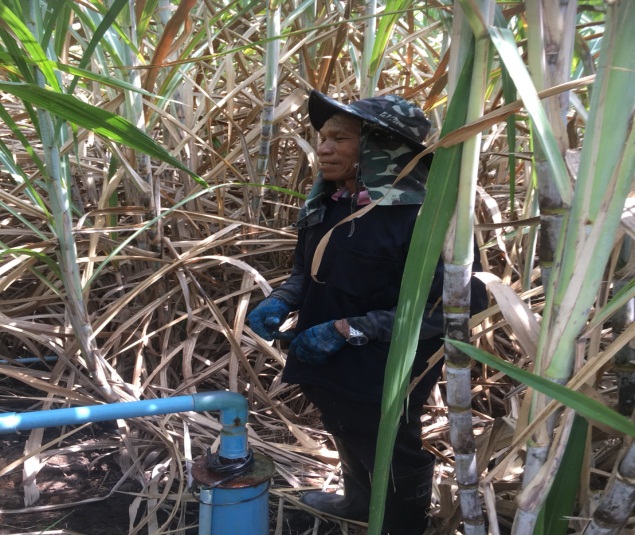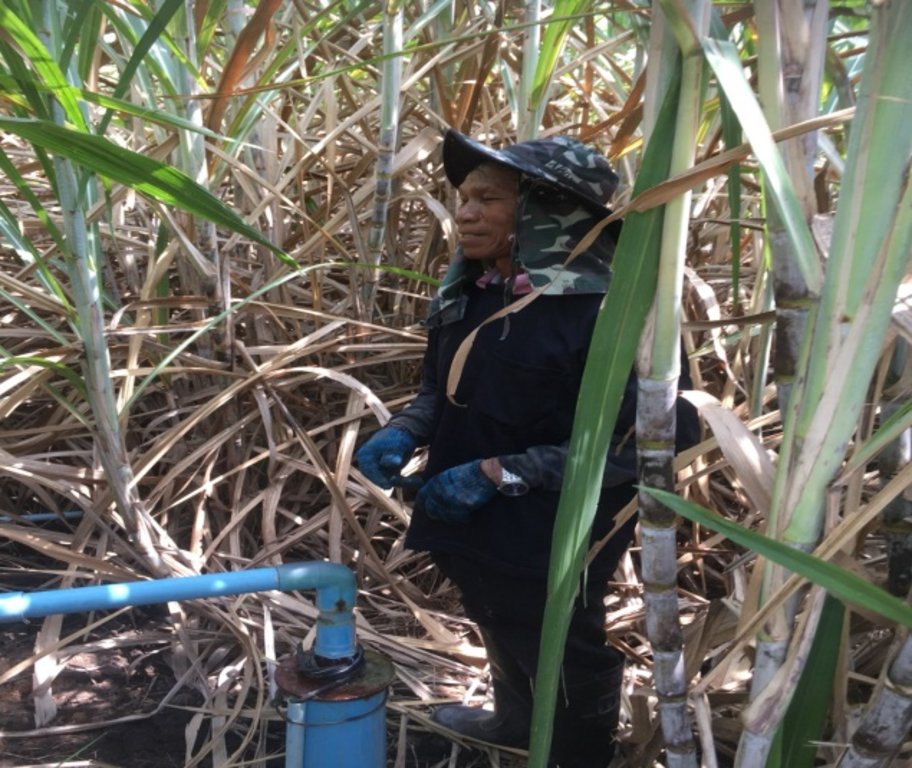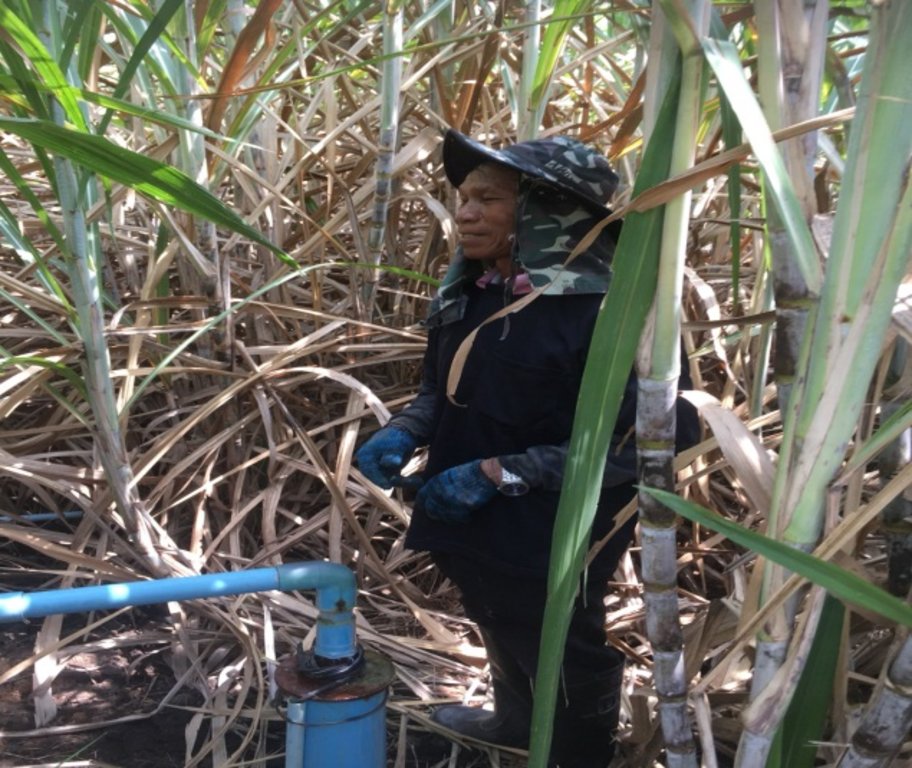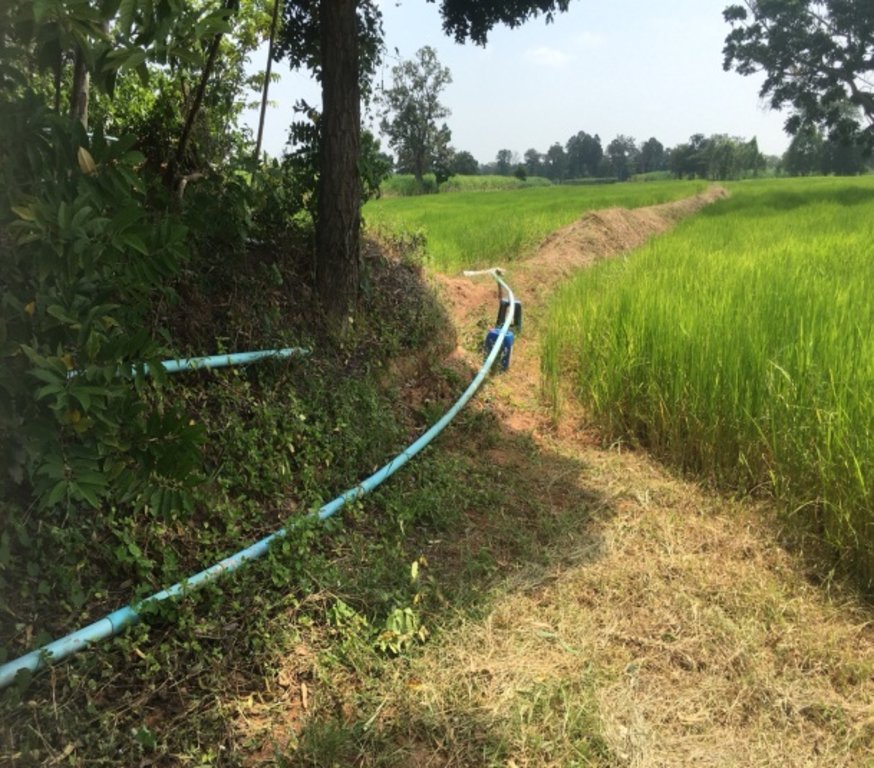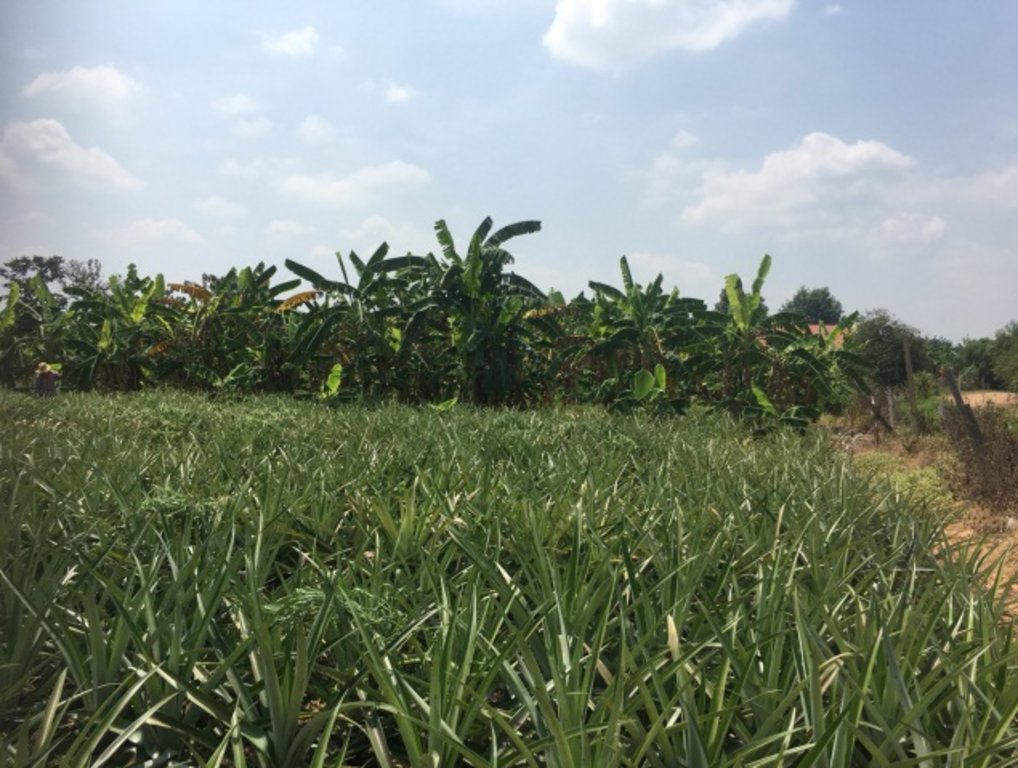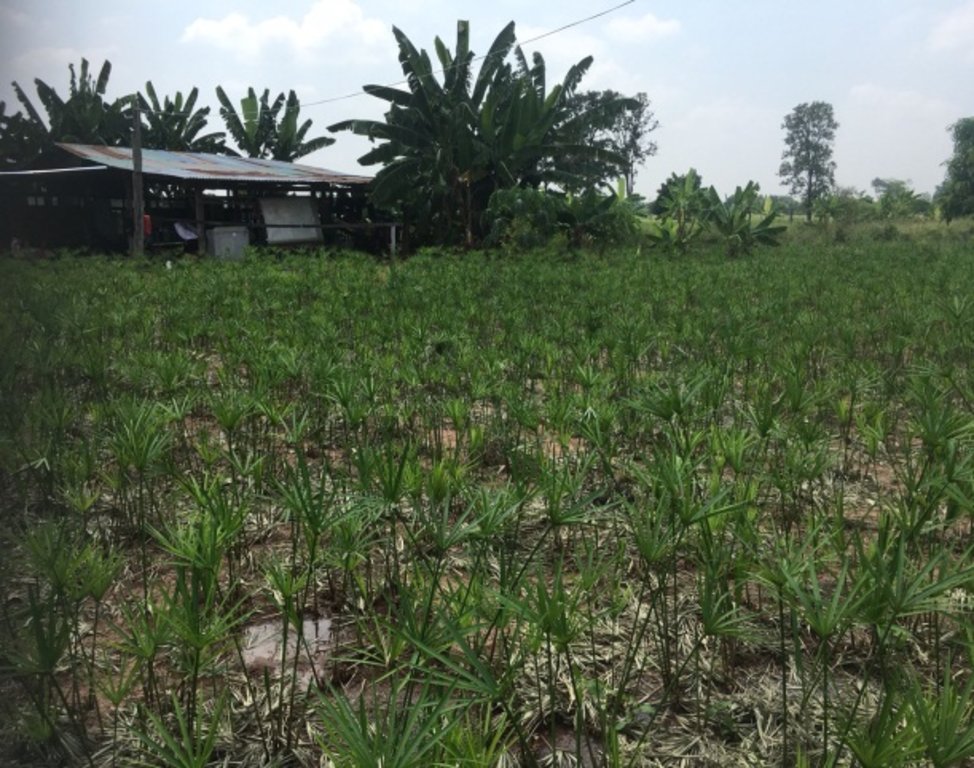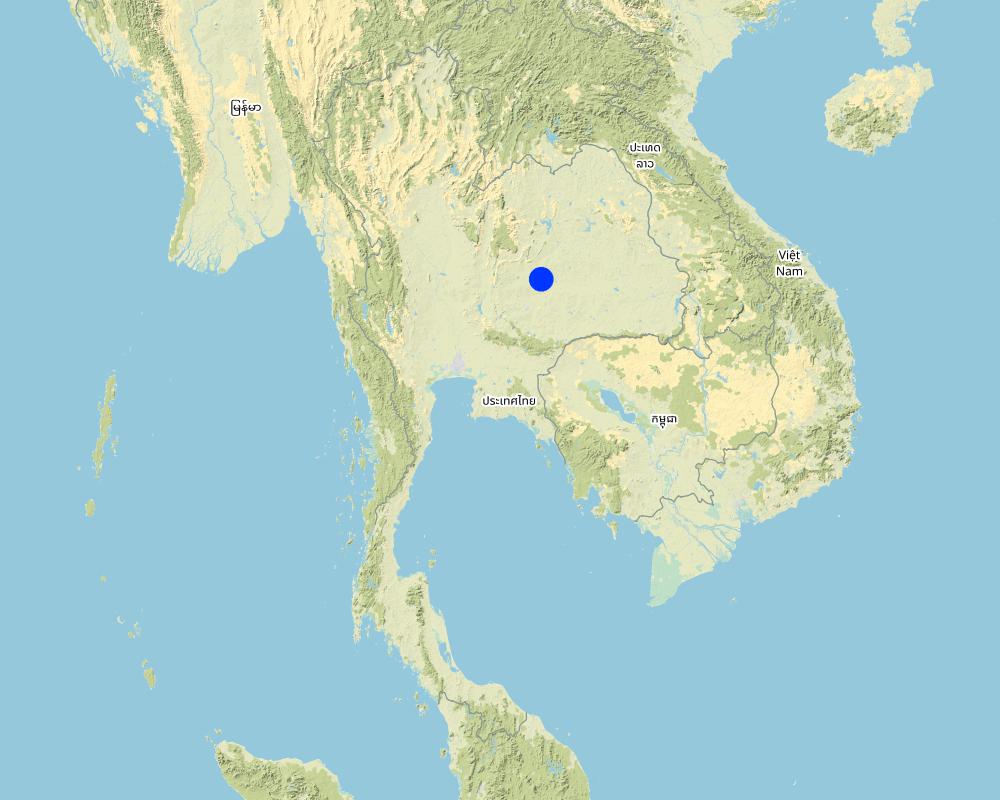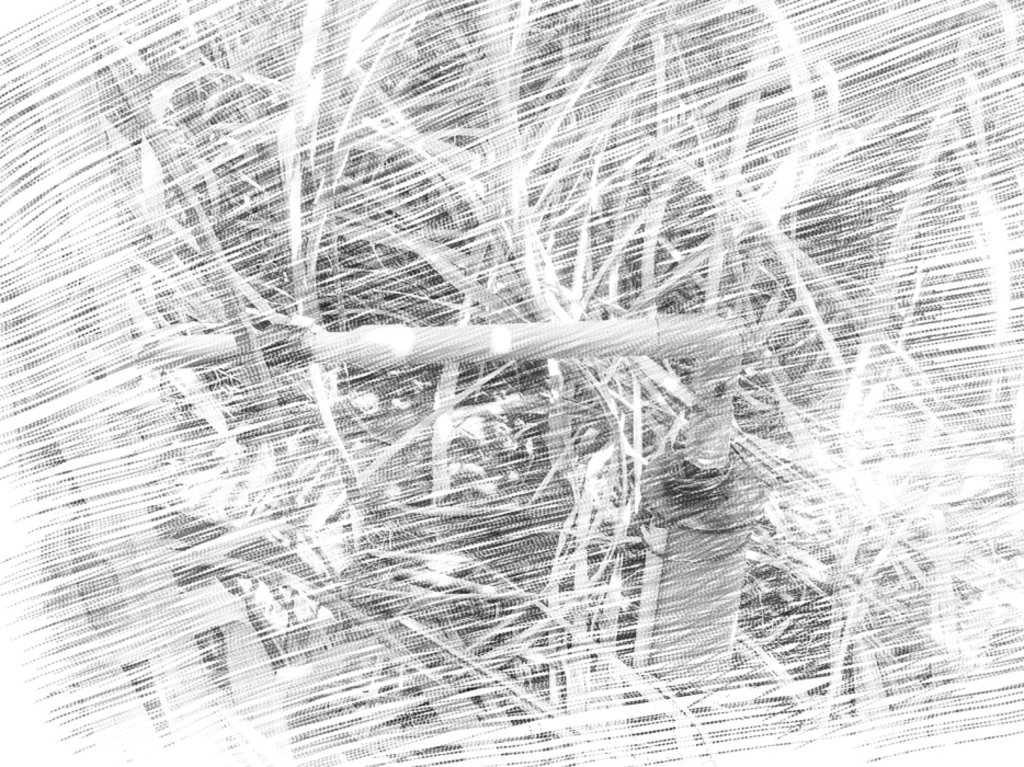Using shallow wells for crops and lowering the saline groundwater table [Thailand]
- Creation:
- Update:
- Compiler: Kaewjai Oechaiyaphum
- Editor: –
- Reviewers: William Critchley, Pitayakon Limtong, Rima Mekdaschi Studer, Samran Sombatpanit, Joana Eichenberger
shallow well
technologies_4391 - Thailand
View sections
Expand all Collapse all1. General information
1.2 Contact details of resource persons and institutions involved in the assessment and documentation of the Technology
Key resource person(s)
land user:
SooPho Boonchu
Land user
Thailand
co-compiler:
SLM specialist:
SLM specialist:
SLM specialist:
SLM specialist:
SLM specialist:
Prawanna Prasit
Technical for Land Development Group , Land Development Regional Office 3 , Land Development Department.
Thailand
National consultant:
Name of project which facilitated the documentation/ evaluation of the Technology (if relevant)
Decision Support for Mainstreaming and Scaling out Sustainable Land Management (GEF-FAO / DS-SLM)Name of project which facilitated the documentation/ evaluation of the Technology (if relevant)
Book project: where the land is greener - Case Studies and Analysis of Soil and Water Conservation Initiatives Worldwide (where the land is greener)Name of the institution(s) which facilitated the documentation/ evaluation of the Technology (if relevant)
Land Development Department (Land Development Department) - Thailand1.3 Conditions regarding the use of data documented through WOCAT
The compiler and key resource person(s) accept the conditions regarding the use of data documented through WOCAT:
Yes
1.4 Declaration on sustainability of the described Technology
Is the Technology described here problematic with regard to land degradation, so that it cannot be declared a sustainable land management technology?
No
Comments:
Through this technology, farmers can pump water from shallow wells for agriculture throughout the year: it can lower the groundwater table and reduce salinity. This technology has resulted in reduction salinity in surrounding low land areas. Hence, shallow wells have been accepted by land users.
2. Description of the SLM Technology
2.1 Short description of the Technology
Definition of the Technology:
Pumping groundwater from shallow wells for agriculture can control the groundwater table in recharge areas. It helps to manage saline aquifers and reduce soil salinity. Such shallow wells range from 25 to 30 meters deep. This technology is very well-accepted by the land users.
2.2 Detailed description of the Technology
Description:
The shallow well is a structure created in the ground by digging or drilling to access water resources. This example of shallow wells is their use in recharge areas to lower groundwater tables. The technology is a subproject of a larger LDD initiative. The technology has been promoted by the Land Development Department at Bua Yai district Nakhon Ratchasima province since 2014. The objectives of the main project are (1) to provide water resources in recharge areas for agriculture: (2) to reduce the amount of saline groundwater and (3) to set up positive economic impact measures.
The process of technology establishment comprises 1) a recharge area survey in salt-affected areas, 2) drilling shallow wells to 25-30 meters depth, 3) installing 5.5 hp gasoline pumps and testing water quality, 4) pumping groundwater and distributing it to the cultivated areas.
Shallow well technology has been implemented on the fields of Mr. Boonchu Supho, Ban Nong Mek, Moo 9, T.Dan Chang, A. Buayai, Nakhon Ratchasima Province. Mr. Boonchu Supho has 21 rai (approx. 3.4 hectares), undulating area with a 2-5% slope, situated at approx. 200 meters above sea level, with a tropical climate, and soil which is classified as being in the series of Kula Ronghai (Ki). This area is upland, and located in the recharge area. Mr. Boonchu Supho has 13 rai (approx. 2 hectares) of lowland rice fields and one shallow well.
In the past, water scarcity was the main issue with his land. Droughts resulted in water scarcity and low productivity. After excavating a shallow well in 2014, groundwater was used for 19 rai of cultivation. Due to soil salinity reduction, rice yields increased to 590 kg/rai (approx. 3700 kg/ha: an increase of approx. 47.4%). Sugar cane yield increased to 30 ton/rai. Moreover, land users can use land more efficiently with mixed plantations of banana, pineapples, sweet bamboo, chilies, galangal and lemongrass to generate income. Even with a drought in 2018, his land had enough water for cultivation, while rice fields in the surrounding area faced water scarcity problem.
In conclusion, the benefits of the shallow well are 1) lowering the groundwater table and reducing salinity, 2) enhancing rice and sugar cane yields, 3) ability to cultivate throughout the year and 4) better soil properties and a better environment. However, the disadvantage of the shallow well is that farmers have to pay for electricity (around 1,200 THB/ 9 months or 10,800 THB/year).
2.3 Photos of the Technology
General remarks regarding photos:
Using shallow well for planting in the recharge area
2.4 Videos of the Technology
Comments, short description:
To interview Mr. Boonchu Supho
Date:
09/10/2017
Location:
Ban Koksa-ard Moo 9 T.Danchanget, A.Buayai, Nakhon-Ratchasima
Name of videographer:
.Jilayus Sommutram
2.5 Country/ region/ locations where the Technology has been applied and which are covered by this assessment
Country:
Thailand
Region/ State/ Province:
Nakhon Ratchasima
Further specification of location:
Ban Koksa-ard Moo 10 T.Danchang, A.Buayai
Comments:
Mr. Boonchu Supho has in total 21 rai, divided into 1) Recharge area, which is located in the upland zone. Land utilization comprises 2 rai of residence and shallow well, 1.5 rai of the sugar cane field, 1 rai of a banana field, 1 rai of sweet bamboo, 1 rai of pineapple and 0.5 rai of chillies, galangal, and lemongrass. 2) Discharge area, which is located in a low land area. This area has 13 rai of in-season rice
Map
×2.6 Date of implementation
Indicate year of implementation:
2014
If precise year is not known, indicate approximate date:
- less than 10 years ago (recently)
2.7 Introduction of the Technology
Specify how the Technology was introduced:
- through projects/ external interventions
Comments (type of project, etc.):
The Land Development Department and local authorities created a demonstration plot to solve the saline soil problem under the LDD project (on preventing soil salinity and to lower the groundwater table in the recharge area) in Bua Yai district. Nakhon Ratchasima Province, since 2014
3. Classification of the SLM Technology
3.1 Main purpose(s) of the Technology
- improve production
- reduce, prevent, restore land degradation
- create beneficial economic impact
- prevents soil salinity and to lower the groundwater table on recharge area
3.2 Current land use type(s) where the Technology is applied
Land use mixed within the same land unit:
No

Cropland
- Annual cropping
- Perennial (non-woody) cropping
- vegetable
Annual cropping - Specify crops:
- cereals - rice (wetland)
- vegetables - other
Perennial (non-woody) cropping - Specify crops:
- banana/plantain/abaca
- pineapple
- sugar cane
Number of growing seasons per year:
- 2
Specify:
Land user growing rice 1 time/year, growing sugar cane 2 times/3 years and using of water punping for vegetable growing during rain delay season/ drought situation
Is intercropping practiced?
No
Is crop rotation practiced?
No

Waterways, waterbodies, wetlands
Main products/ services:
shallow well
Comments:
An excavating shallow well on recharge area was to lower groundwater table and prevent soil salinity in recharge area. Groundwater was used for rice, sugar cane, banana, pineapple and vegetable growing. This technology has increased productivity up to 47.4% in rice: sugar cane has more than doubled its yields.
3.3 Has land use changed due to the implementation of the Technology?
Has land use changed due to the implementation of the Technology?
- Yes (Please fill out the questions below with regard to the land use before implementation of the Technology)
Land use mixed within the same land unit:
No

Cropland
- Annual cropping
- Perennial (non-woody) cropping
- vegetable
Annual cropping - Specify crops:
- cereals - rice (wetland)
- vegetables - other
Perennial (non-woody) cropping - Specify crops:
- pineapple
- sugar cane
- sweet bamboo
Is intercropping practiced?
No
Is crop rotation practiced?
No
Comments:
An excavated shallow well in the recharge area was to lower groundwater table and prevents soil salinity in the recharge area. Groundwater was used for rice, sugar cane, banana, pineapple, and vegetable growing. This technology has increased productivity up to 47.4% in rice: sugar cane has more than doubled its yields.
3.4 Water supply
other (e.g. post-flooding):
- shallow well
Comments:
Land users know how drought or rain can delay affect productivity. Hence, land users have decided to engage in this project
3.5 SLM group to which the Technology belongs
- rotational systems (crop rotation, fallows, shifting cultivation)
- ground water management
- desalination
3.6 SLM measures comprising the Technology

agronomic measures
- A1: Vegetation/ soil cover
- A2: Organic matter/ soil fertility

structural measures
- S11: Others
Comments:
Groundwater from the shallow well was used for 19 rai of plantation area. The result shows that this technology can increase soil moisture; make a better environment, crop residue from post-harvest can enhance soil organic matter and soil fertility
3.7 Main types of land degradation addressed by the Technology

chemical soil deterioration
- Cs: salinization/ alkalinization

physical soil deterioration
- Pc: compaction
- Pk: slaking and crusting

biological degradation
- Bc: reduction of vegetation cover
- Bq: quantity/ biomass decline
- Bl: loss of soil life

water degradation
- Hq: decline of groundwater quality
Comments:
There is not much organic fertilizing in 19 rai of land. Most organic fertilizer has been used in vegetable growing while other plantations are usually chemical fertilizing. Hence, increasing crop production needs more chemical fertilizing.
3.8 Prevention, reduction, or restoration of land degradation
Specify the goal of the Technology with regard to land degradation:
- reduce land degradation
- adapt to land degradation
Comments:
The land user has used shallow well technology during drought and rain delay situation since 2014-2018. They found that using shallow wells can reduce groundwater table which might dissolve saline aquifer and spread salinity. Hence, shallow well technology can reduce salinity in lower lying land. With less salt in the topsoil, rice yield has increased to 5-10%
4. Technical specifications, implementation activities, inputs, and costs
4.1 Technical drawing of the Technology
4.2 General information regarding the calculation of inputs and costs
Specify how costs and inputs were calculated:
- per Technology area
Indicate size and area unit:
21 rai own by one selected land user....(e.g. 24 acres, 4.5 hectares)
If using a local area unit, indicate conversion factor to one hectare (e.g. 1 ha = 2.47 acres): 1 ha =:
1 hectare =…6.25 rai
other/ national currency (specify):
THB
Indicate average wage cost of hired labour per day:
300 THB
4.3 Establishment activities
| Activity | Timing (season) | |
|---|---|---|
| 1. | To drilling shallow well with 25-30 meters depth | January 2014 |
| 2. | Sugar fields | May 2014, 2016, 2018 |
| 3. | Pineapple fields | May 2018 |
| 4. | Banana fields | May 2014 |
| 5. | Reed fields | May 2015 |
| 6. | Sweet bamboo fields | May 2015 |
| 7. | Chillies, galangal and lemon grass fields | May 2014-2018 |
| 8. | Rice fields | June 2014-2018 |
Comments:
No irrigation water therefore planting time depends directly upon the period of the early rainy season, which will be May to July
4.4 Costs and inputs needed for establishment
| Specify input | Unit | Quantity | Costs per Unit | Total costs per input | % of costs borne by land users | |
|---|---|---|---|---|---|---|
| Labour | Costs of labor for sugarcane cultivation | puddle | 1.0 | 2500.0 | 2500.0 | |
| Labour | Costs of labor for rice cultivation. | rai | 13.0 | 1150.0 | 14950.0 | |
| Labour | Costs of labor for sugar cane cultivation. | rai | 1.5 | 1200.0 | 1800.0 | |
| Labour | Costs of labor for pineapple cultivation. | rai | 1.0 | 1200.0 | 1200.0 | |
| Equipment | Costs of labor for Banana cultivation | rai | 1.0 | 600.0 | 600.0 | |
| Equipment | Costs of labor for Papyrus cultivation. | rai | 0.5 | 900.0 | 450.0 | |
| Equipment | Costs of labor for Sweet bamboo cultivation. | rai | 1.0 | 600.0 | 600.0 | |
| Equipment | Costs of labor for Chilli, galangal, lemon grass cultivation | rai | 1.0 | 900.0 | 900.0 | |
| Equipment | Cost of shallow water well drilling equipment | puddle | 1.0 | 100000.0 | 100000.0 | |
| Plant material | Bud seedling sugarcane | seedling | 2250.0 | 0.9 | 2025.0 | |
| Plant material | Bud seedling Pineapple | seedling | 2500.0 | 2.0 | 5000.0 | |
| Plant material | Bud seedling Banana | seedling | 100.0 | 10.0 | 1000.0 | |
| Plant material | Bud seedling Papyrus | seedling | 3000.0 | 0.2 | 600.0 | |
| Fertilizers and biocides | Bud seedling sweet bamboo | seedling | 25.0 | 80.0 | 2000.0 | |
| Fertilizers and biocides | Bud seedling Chilli, galangal, lemon grass | seedling | 2000.0 | 1.0 | 2000.0 | |
| Fertilizers and biocides | Seedling rice KDML105 | seedling | 65.0 | 25.0 | 1625.0 | |
| Fertilizers and biocides | Chemical fertilizer 15-15-15 | kg | 300.0 | 13.0 | 3900.0 | |
| Fertilizers and biocides | Chicken manure | kg | 2000.0 | 2.0 | 4000.0 | |
| Other | Electricity charge | hr | 240.0 | 5.0 | 1200.0 | |
| Other | Machinery | rai | 19.0 | 500.0 | 9500.0 | |
| Total costs for establishment of the Technology | 155850.0 | |||||
| Total costs for establishment of the Technology in USD | 155850.0 | |||||
If land user bore less than 100% of costs, indicate who covered the remaining costs:
The Land Development Department supports expenses for drilling shallow wells approximately 100,000 THB. The land users are involved in the maintenance of shallow wells at the 2nd year about 2,000 THB and pay for cost of maintenance and electricity bills about 1,200 baht per month for 9 months. Moreover, land users have to paid for farm pond construction under farm pond project of LDD about 2,500 THB.
Comments:
Nong Mek Village, Moo 9, Dan Chang Subdistrict, Bua Yai District, Nakhon Ratchasima Province located on the recharge area which has totally 1,000 rai. Recharge area is a type of upland where use for cassava and sugar cane planting. Most land users have not much knowledge and motivation on shallow well drilling. Hence, Land Development Department comes to train, solution on salt-affected soil with the project on prevents soil salinity, and to lower the groundwater table on recharge area since 2014. The shallow well technology has been implemented through the demonstration plot, which is the first learning center of salt-affected soil management on the recharge area
4.5 Maintenance/ recurrent activities
| Activity | Timing/ frequency | |
|---|---|---|
| 1. | Maintenance | 1 Times/year |
| 2. | Electricity charge | 1 Times/month |
Comments:
Shallow well which supported by LDD is a type of 5.5 hp gasoline pump then, land users try to use the electric water pump instead. The use of electrical water pump can increases yield productivity and enhance land users’ income. This is resulting in a better life.
4.6 Costs and inputs needed for maintenance/ recurrent activities (per year)
| Specify input | Unit | Quantity | Costs per Unit | Total costs per input | % of costs borne by land users | |
|---|---|---|---|---|---|---|
| Equipment | electricity charge,5 baht per unit 8 hours per day, 360 days / year | time | 2880.0 | 5.0 | 14400.0 | |
| Equipment | Machinery | time | 1.0 | 2000.0 | 2000.0 | |
| Total costs for maintenance of the Technology | 16400.0 | |||||
| Total costs for maintenance of the Technology in USD | 16400.0 | |||||
Comments:
Land users do maintenance this technology by themselves, without hiring labor. There has only cost of modifying.
4.7 Most important factors affecting the costs
Describe the most determinate factors affecting the costs:
Cost of shallow wells implementation at the 1st year consists of 100,000 THB of labor hiring, equipment, and installation. Besides, land users have to pay 2,500 THB for farm pond construction
The expenditure at the 1st year in 2014, pumping groundwater needs to use electricity 8 hours/ 270 day. The amount of water pumping has distributed to 13 rai of rice fields, 1.5 rai of sugar cane fields, 1 rai of chilies, galangal and lemongrass fields. The expenditure at the 1st year with 19 rai is 42,050 THB combine with electricity charge 10,800 THB. Thus, the grand total of expenditure is 52,850 THB.
The income from crop production at 1st year, land users sold rice yield and got 109,200 THB (the average amount of yield is 560 kg/rai, totally gain yield is 7,280 kg, price of rice yield is 15 THB/kg). Land users got 40,500 THB from sugar cane production (the average amount of yield is 30 ton/rai, totally gain yield is 45 ton, price of sugar cane yield is 900 THB/ton). Moreover, land users also got 2,000 THB/month or 24,000 THB/year from chilies, galangal, and lemongrass production. Thus, the grand total of income is 173,700 THB and net income is 120,850 THB
Cost and income at 2nd year in 2015 are described as following;
The expenditure at 2nd year in 2015, pumping groundwater needs to use electricity 8 hours/ 270 day. The amount of water pumping has distributed to 13 rai of rice fields, 1.5 rai of sugar cane fields, 1 rai of sweet bamboo, 1 rai of chilies, galangal and lemongrass fields and 0.5 rai of reed fields. The expenditure at the 2nd year is 40,475 THB combine with electricity charge 10,800 THB and 2,000 THB of water pump modifying fee Thus, the grand total of expenditure is 51,275 THB.
The income from crop production at the 2nd year, land users sold rice yield and got 109,200 THB (the average amount of yield is 560 kg/rai, totally gain yield is 7,280 kg, price of rice yield is 15 THB/kg). Land users got 40,500 THB from sugar cane production (the average amount of yield is 30 ton/rai, totally gain yield is 45 ton, price of sugar cane yield is 900 THB/ton). Moreover, land users also got 3,500 THB/month or 42,000 THB/year from reed, sweet bamboo, chilies, galanga, and lemongrass production. Thus, the grand total of income is 191,700 THB and net income is 140,425 THB
The expenditure at the 3rd year in 2016, pumping groundwater needs to use electricity 8 hours/ 270 day. The amount of water pumping has distributed to 13 rai of rice fields, 1.5 rai of sugar cane fields, 1 rai of sweet bamboo, 1 rai of chilies, galangal and lemongrass fields and 1 rai of reed fields and 0.5 rai of reed. The expenditure at the 3rd year is 40,800 THB combine with electricity charge 10,800 THB and 2,000 THB of water pump modifying fee Thus, the grand total of expenditure is 51,600 THB.
The income from crop production at 3rd year, land users sold rice yield and got 109,200 THB (the average amount of yield is 560 kg/rai, totally gain yield is 7,280 kg, price of rice yield is 15 THB/kg). Land users got 40,500 THB from sugar cane production (the average amount of yield is 30 ton/rai, totally gain yield is 45 ton, price of sugar cane yield is 900 THB/ton). Moreover, land users also got 3,500 THB/month or 42,000 THB/year from reed, sweet bamboo, chilies, galangal, and lemongrass production. Thus, the grand total of income is 191,700 THB and net income is 140,100 THB
The expenditure at the 4th year in 2017, pumping groundwater needs to use electricity 8 hours/ 270 day. The amount of water pumping has distributed to 13 rai of rice fields, 1.5 rai of sugar cane fields, 1 rai of sweet bamboo, 1 rai of chilies, galangal and lemongrass fields and 1 rai of reed fields and 0.5 rai of reed. The expenditure at the 4th year is 37,125 THB combine with electricity charge 10,800 THB and 2,000 THB of water pump modifying fee Thus, the grand total of expenditure is 47,925 THB.
The income from crop production at 4th year, land users sold rice yield and got 109,200 THB (the average amount of yield is 560 kg/rai, totally gain yield is 7,280 kg, price of rice yield is 15 THB/kg). Land users got 40,500 THB from sugar cane production (the average amount of yield is 30 ton/rai, totally gain yield is 45 ton, price of sugar cane yield is 900 THB/ton). Moreover, land users also got 3,500 THB/month or 42,000 THB/year from reed, sweet bamboo, chilies, galangal, and lemongrass production. Thus, the grand total of income is 191,700 THB and net income is 143,775 THB
The expenditure at the 5th year in 2018, pumping groundwater needs to use electricity 8 hours/ 270 day. The amount of water pumping has distributed to 13 rai of rice fields, 1.5 rai of sugar cane fields, 1 rai of sweet bamboo, 1 rai of banana, 1 rai of chilies, galangal and lemongrass fields,1 rai of reed
5. Natural and human environment
5.1 Climate
Annual rainfall
- < 250 mm
- 251-500 mm
- 501-750 mm
- 751-1,000 mm
- 1,001-1,500 mm
- 1,501-2,000 mm
- 2,001-3,000 mm
- 3,001-4,000 mm
- > 4,000 mm
Specify average annual rainfall (if known), in mm:
1084.00
Specifications/ comments on rainfall:
Average annual rainfall from 2008-2013
Indicate the name of the reference meteorological station considered:
Meteorological Department
Agro-climatic zone
- semi-arid
Temperatures average 13-39 degrees Celsius, average relative humidity 55-89.%
5.2 Topography
Slopes on average:
- flat (0-2%)
- gentle (3-5%)
- moderate (6-10%)
- rolling (11-15%)
- hilly (16-30%)
- steep (31-60%)
- very steep (>60%)
Landforms:
- plateau/plains
- ridges
- mountain slopes
- hill slopes
- footslopes
- valley floors
Altitudinal zone:
- 0-100 m a.s.l.
- 101-500 m a.s.l.
- 501-1,000 m a.s.l.
- 1,001-1,500 m a.s.l.
- 1,501-2,000 m a.s.l.
- 2,001-2,500 m a.s.l.
- 2,501-3,000 m a.s.l.
- 3,001-4,000 m a.s.l.
- > 4,000 m a.s.l.
Indicate if the Technology is specifically applied in:
- not relevant
Comments and further specifications on topography:
Geography The Bua Yai district is located in the north of Nakhon Ratchasima. On the Korat Plateau
5.3 Soils
Soil depth on average:
- very shallow (0-20 cm)
- shallow (21-50 cm)
- moderately deep (51-80 cm)
- deep (81-120 cm)
- very deep (> 120 cm)
Soil texture (topsoil):
- medium (loamy, silty)
Soil texture (> 20 cm below surface):
- medium (loamy, silty)
Topsoil organic matter:
- low (<1%)
If available, attach full soil description or specify the available information, e.g. soil type, soil PH/ acidity, Cation Exchange Capacity, nitrogen, salinity etc.
The surface soil is sandy loam. The bottom soil is sandy loam soil. The pH is between 7.5 - 8.5. Salinity is at a salty level. Have salt stains on the surface throughout the year and have very low P and K.
5.4 Water availability and quality
Ground water table:
< 5 m
Availability of surface water:
medium
Water quality (untreated):
for agricultural use only (irrigation)
Water quality refers to:
ground water
Is water salinity a problem?
Yes
Specify:
Slightly saline
Is flooding of the area occurring?
No
Comments and further specifications on water quality and quantity:
saline groundwater
5.5 Biodiversity
Species diversity:
- medium
Habitat diversity:
- medium
Comments and further specifications on biodiversity:
Before drilling shallow wells there were very few animals living in this area. After 1 year of shallow well being implemented, there is an increase in food and plant sources, the habitat of living things. To implement the technology resulting in more organisms such as fish, birds, rats, earthworms, and insects
5.6 Characteristics of land users applying the Technology
Sedentary or nomadic:
- Sedentary
Market orientation of production system:
- mixed (subsistence/ commercial)
Off-farm income:
- 10-50% of all income
Relative level of wealth:
- rich
Individuals or groups:
- individual/ household
Level of mechanization:
- manual work
- mechanized/ motorized
Gender:
- men
Age of land users:
- elderly
Indicate other relevant characteristics of the land users:
Land users are diligent in their work and patient. They carried out crop rotation throughout the year. The, they get more revenue daily, monthly and yearly.
5.7 Average area of land used by land users applying the Technology
- < 0.5 ha
- 0.5-1 ha
- 1-2 ha
- 2-5 ha
- 5-15 ha
- 15-50 ha
- 50-100 ha
- 100-500 ha
- 500-1,000 ha
- 1,000-10,000 ha
- > 10,000 ha
Is this considered small-, medium- or large-scale (referring to local context)?
- medium-scale
Comments:
Land users drill a shallow well on the recharge area in order to pump groundwater for planting throughout the year to reduce expenses and increase family income
5.8 Land ownership, land use rights, and water use rights
Land ownership:
- individual, titled
Land use rights:
- individual
- Rainfed.
Are land use rights based on a traditional legal system?
Yes
Comments:
Land users can decide to use the land by themselves. They did crop rotation by using water pumped from shallow wells. The Land users could be an example for the other that could be shown by surrounding farmer want to engage in this project.
5.9 Access to services and infrastructure
health:
- poor
- moderate
- good
education:
- poor
- moderate
- good
technical assistance:
- poor
- moderate
- good
employment (e.g. off-farm):
- poor
- moderate
- good
markets:
- poor
- moderate
- good
energy:
- poor
- moderate
- good
roads and transport:
- poor
- moderate
- good
drinking water and sanitation:
- poor
- moderate
- good
financial services:
- poor
- moderate
- good
6. Impacts and concluding statements
6.1 On-site impacts the Technology has shown
Socio-economic impacts
Production
crop production
crop quality
risk of production failure
product diversity
production area
Water availability and quality
drinking water availability
drinking water quality
water availability for livestock
Income and costs
expenses on agricultural inputs
farm income
workload
Socio-cultural impacts
food security/ self-sufficiency
health situation
land use/ water rights
cultural opportunities
recreational opportunities
community institutions
national institutions
SLM/ land degradation knowledge
conflict mitigation
situation of socially and economically disadvantaged groups
Ecological impacts
Water cycle/ runoff
water quantity
water quality
harvesting/ collection of water
surface runoff
excess water drainage
groundwater table/ aquifer
evaporation
Soil
soil moisture
soil cover
soil loss
soil accumulation
soil crusting/ sealing
soil compaction
nutrient cycling/ recharge
salinity
soil organic matter/ below ground C
acidity
Biodiversity: vegetation, animals
Vegetation cover
biomass/ above ground C
plant diversity
invasive alien species
animal diversity
beneficial species
habitat diversity
pest/ disease control
Climate and disaster risk reduction
flood impacts
landslides/ debris flows
drought impacts
impacts of cyclones, rain storms
emission of carbon and greenhouse gases
fire risk
wind velocity
micro-climate
6.2 Off-site impacts the Technology has shown
water availability
reliable and stable stream flows in dry season
downstream flooding
downstream siltation
groundwater/ river pollution
buffering/ filtering capacity
wind transported sediments
damage on neighbours' fields
damage on public/ private infrastructure
impact of greenhouse gases
6.3 Exposure and sensitivity of the Technology to gradual climate change and climate-related extremes/ disasters (as perceived by land users)
Comments:
An opinion of the land user, there are many situations such as rain delay during 2014-2016, drought during December – April 201 and flood in rainy season while rain delay in 2018 can lead to water scarcity problem. However, that situation cannot impact farmland with shallow wells.
6.4 Cost-benefit analysis
How do the benefits compare with the establishment costs (from land users’ perspective)?
Short-term returns:
positive
Long-term returns:
very positive
How do the benefits compare with the maintenance/ recurrent costs (from land users' perspective)?
Short-term returns:
positive
Long-term returns:
very positive
Comments:
Land users to pay a 2,000 baht machinery as a long-term investment to operate for several years and pay the electric fee for water pumping but land users can have 10,800 THB and the revenue daily, monthly and annually and reduce costs in the household
6.5 Adoption of the Technology
- 1-10%
Of all those who have adopted the Technology, how many did so spontaneously, i.e. without receiving any material incentives/ payments?
- 0-10%
Comments:
Land user and other farmer have knowledge and understanding on an advantage of shallow well technology implemented. Some of them drill water well by themselves.
6.6 Adaptation
Has the Technology been modified recently to adapt to changing conditions?
Yes
other (specify):
changing practice
Specify adaptation of the Technology (design, material/ species, etc.):
Land users have modified water pump machine by use electric pump instead of a gasoline pump
6.7 Strengths/ advantages/ opportunities of the Technology
| Strengths/ advantages/ opportunities in the land user’s view |
|---|
| Reduce soil salinity |
| Save money by bringing rice and vegetables grown into household food. |
| Increase sales revenue, rice, sugarcane, pineapple, Papyrus, banana, lemongrass, galangal, chili, and sweet bamboo. |
| Save money by bringing rice and vegetables grown into household food. |
| Strengths/ advantages/ opportunities in the compiler’s or other key resource person’s view |
|---|
| Pumping water from shallow wells for agricultural use, can reduce groundwater table and prevent salinity that is a great measure on land degradation mitigation |
| The land user can have food from plant production from their farms. The land user can reduce household expenses. Left to sell, resulting in a daily, monthly and annual income and make a better life. |
| Biodiversity enhancement, there are many plants and living things such as earthworms, birds, fish, frogs, and insects. This is resulting in a balanced ecosystem. |
6.8 Weaknesses/ disadvantages/ risks of the Technology and ways of overcoming them
| Weaknesses/ disadvantages/ risks in the land user’s view | How can they be overcome? |
|---|---|
| After one year of shallow wells implemented, land users must take care and maintain shallow wells as usual. | Make an agreement on taking care of shallow wells after implemented. |
| To inform LDD when something is wrong |
| Weaknesses/ disadvantages/ risks in the compiler’s or other key resource person’s view | How can they be overcome? |
|---|---|
| Other land users who are not participating. will not get knowledge about the use of shallow well to reduce the level of underground water. | LDD staff / Land users participating in the project to advise or educate other farmers on how to join the project. |
7. References and links
7.1 Methods/ sources of information
- field visits, field surveys
Visit 1 farmer/user's land
- interviews with land users
Interview with 1 farmer.
- interviews with SLM specialists/ experts
The Land Development Department officers and planners (7)
When were the data compiled (in the field)?
03/09/2018
Comments:
To be clear on the result of the technology implementation there should be soil sampling as well.
7.2 References to available publications
Title, author, year, ISBN:
Evaluate the project using water from shallow wells to prevent. Distribution of saline soil as farmers participate in Bua Yai District,Nakhon Ratchasima Province (Kamolthip Sasithorn: 2017
Available from where? Costs?
http://www.ldd.go.th
Title, author, year, ISBN:
Study of groundwater level changes to rice production in an integrated saline soil development project area, Bua Yai District, Nakhon Ratchasima Province (Bowon Buakhao: 2017)
Available from where? Costs?
http://www.ldd.go.th
7.3 Links to relevant online information
Title/ description:
where the land is greener - Case Studies and Analysis of Soil and Water Conservation Initiatives Worldwide
URL:
https://www.wocat.net/library/media/27/
7.4 General comments
Some part of the questionnaire is very complex such as the cost of input
Links and modules
Expand all Collapse allLinks
No links
Modules
No modules


